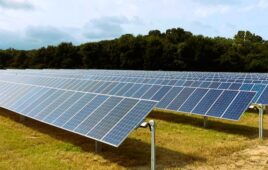The U.S. energy storage market set a new record in the fourth quarter of 2021, with new system installations totaling 4,727 MWh.
According to Wood Mackenzie, a Verisk business, and the American Clean Power Association’s (ACP) latest “U.S. Energy Storage Monitor” report, Q4 2021 saw more capacity installed than in the first three quarters combined, despite project delays.
Residential storage had its strongest quarter to date with 123 MW installed, beating the previous quarterly record of 110 MW in Q1 2021. Increasingly effective solar + storage sales in markets outside of California helped establish the new quarterly benchmark and resulted in a national annual total of 436 MW.
By 2026, annual installations in the residential segment are expected to hit 2 GW/5.4 GWh, with frontrunners in California, Puerto Rico, Texas, and Florida leading that market segment.
“Puerto Rico’s position in the residential U.S. solar + storage market comes as no surprise and demonstrates how outages can drive battery adoption, with thousands of new residential installs emerging each quarter and competition increasing between local installers,” said Chloe Holden, an analyst with Wood Mackenzie’s energy storage team.
Annual deployments of grid-scale storage nearly tripled year-over-year to 3 GW/9.2 GWh. Despite a record year, the grid-scale market didn’t meet expectations in 2021, with supply chain challenges delaying more than 2 GW of capacity into 2022 and 2023. Wood Mackenzie forecasts that supply chain pressures and delays within interconnection queue processing will persist through 2024.
 “Even in the face of continued macro-economic headwinds, interconnection delays, and lack of proactive federal policy, increasing demand for resilient clean energy and volatility in the price of fuel-based generation will drive energy storage deployment forward,” said Jason Burwen, VP for energy storage at American Clean Power.
“Even in the face of continued macro-economic headwinds, interconnection delays, and lack of proactive federal policy, increasing demand for resilient clean energy and volatility in the price of fuel-based generation will drive energy storage deployment forward,” said Jason Burwen, VP for energy storage at American Clean Power.
System component price gains experienced over recent years have nearly been wiped out by higher costs for raw materials and transportation. Specifically, battery module pricing saw the largest increase of all system components due to the increased cost of raw materials.
The non-residential storage segment delivered 131 MWh in the fourth quarter resulting in 162 MW/350 MWh of total annual deployments in 2021. Segment demand was driven by increased storage attachment rates within the community solar markets of New York and Massachusetts.
News item from WoodMac





Greetings,
I live in Wash. St., Everett Area. I’ve been looking into residential back-up battery storage units for my existing solar system. I have a 36 panel system. I’m finding that the storage batteries are very expensive and don’t seem to have a long life before replacement is due (usually 10yrs). I really would like a battery storage system, but this seem to be a very expensive endeavor. Are there any current, or future systems with a long life and affordable? Any suggestions?
In Puerto Rico the driving force was a hurricane named Maria and the incompetence of the local power authority PREPA. In California it is “mandate” madness the race for decarbonization and the onerous attempts of the rote IOU utilities to insert themselves in the “process” and assure they keep their “regulated monopolies” no matter what it costs the retail ratepayers. In California it recently has been the attempt to gut net metering with Democrat backed AB1139, when that didn’t work NEM 3.0 was attacked with a hatchet by the utilities to do what AB1139 proposed with the “blessing” of the CPUC.
I’m thinking Wood Mackenzie is off on the amount of residential energy storage that will be installed over the next few years. Just California alone, it has gone from, I’m going to get some solar PV and energy storage someday when the “price” comes down, to, I can’t afford NOT to get solar PV and energy storage at the rate of electricity in California. Change is coming, be it with a warm blanket and a bedtime story or a hammer and a war cry. Change comes in waves, first people get tired of the waves of usury washing over them, then as this keeps happening, folks get tired (of being tired), the “powers that be” are not giving them relief from the usury. By the time folks get to the tired of being tired of being tired, they will open their big boy or big girl wallets and adopt the technology that personally gives them relief from the usury.